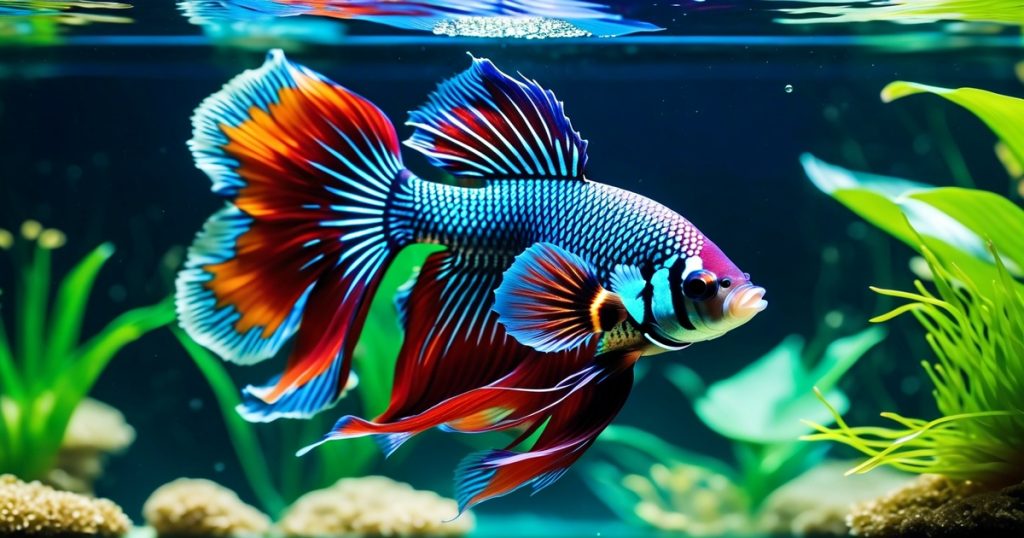Ever wondered about the visual prowess of Betta fish? These vibrant aquatic creatures are known for their dazzling colors and distinctive personalities. But how far can Betta fish see? Exploring the visual capabilities of betta species sheds light on their natural behaviors and habitat preferences.
The range of their vision can also aid in creating enriching environments for them in captivity. Let’s dive into the fascinating world of Betta fish vision, uncovering just how much they can perceive and what this means for their well-being.
Table of Contents
ToggleExploring the Visual Range of Betta Fish

Adapted Vision
Betta fish, species, have a visual range of about 10 inches, which means they can see objects clearly within this distance. Their vision is adapted for spotting prey and navigating their environment. This adaptation helps species survive in the wild by allowing them to detect potential food sources and avoid predators.
Betta fish, species, use their keen eyesight to identify suitable hiding spots, find food, and interact with other fish. Their ability to see up to 10 inches ahead enables the species to spot small prey like insects or larvae in the water. Understanding how far betta fish, a species, can see is crucial for creating an environment that mimics their natural habitat.
Tank Setup Considerations
When setting up a tank for betta fish species, it’s essential to consider their visual range. Placing decorative objects, plants, or tank mates within their visual range can provide stimulation and mimic their natural surroundings for species. However, overcrowding the tank with too many objects or introducing aggressive tank mates can cause stress for bettas due to constant movement within their field of vision.
To ensure that betta fish feel secure in their environment, providing enough open space along with strategically placed decorations is key. For instance, adding live or artificial plants at different heights in the aquarium creates an interesting landscape while still allowing clear visibility across the tank.
Betta Fish and Color Perception
Wide Spectrum
Betta fish have an impressive ability to see a wide spectrum of colors. They can perceive various shades of red, blue, and green. This exceptional visual capacity plays a crucial role in their everyday lives.
Bettas are known for being attracted to vibrant colors, especially during courtship displays. The striking hues of their potential mates play a significant part in the mating rituals of these beautiful fish.
Color perception goes beyond mere aesthetics for bettas; it impacts their behavior and response to tank decorations. For instance, they may show heightened activity or curiosity towards colorful plants or ornaments within their environment.
Impact on Behavior
The fact that bettas can distinguish different colors influences how betta fish owners choose tank accessories and decorations. Owners often select visually stimulating items to provide enrichment for their pet fish.
Furthermore, understanding the impact of color perception on betta behavior is essential for creating an optimal living space for these captivating creatures. By catering to their extraordinary visual capabilities, owners can ensure that bettas feel comfortable and stimulated in their habitats.
- Bettas perceive a wide range of colors.
- They are attracted to vibrant hues during courtship displays.
- Color perception affects behavior and responses to tank decorations.
- Understanding this helps betta owners create enriching environments.
Night Vision in Betta Fish
Limited Night Vision
Betta fish, also known as Siamese fighting fish, have poor vision in low-light conditions. Their eyes are adapted for bright light and they rely on natural light cycles for their daily activities. Due to this reliance, betta fish exhibit limited night vision, making it challenging for them to see clearly when the lighting is dim.
In low-light conditions, such as during nighttime or in dark environments, betta fish may struggle to perceive their surroundings effectively. This can result in reduced activity levels and feeding behaviors during these periods. The poor vision of betta fish under low-light conditions is attributed to their natural habitat where they are accustomed to brighter environments with ample sunlight.
Betta fish’s visual limitations at night mimic their natural environment where darkness signifies restful periods. In the wild, these fish retreat to sheltered areas or vegetation during the night, exhibiting minimal movement and conserving energy. Similarly, in an aquarium setting with subdued lighting at night, bettas may display similar behaviors by seeking out resting spots and reducing their overall activity level.
Mimicking Natural Environment
The poor vision of betta fish under low-light conditions highlights the importance of replicating their natural environment within aquarium settings. Providing appropriate hiding spots and vegetation can offer comfort and security during nighttime hours while promoting restful behavior similar to that observed in the wild.
Depth Perception in Bettas
Monocular Vision
Betta fish have monocular vision, meaning each eye works independently to process visual information. This affects their depth perception because they lack binocular vision, which allows animals to perceive depth accurately. Without this ability, bettas may struggle to judge distances between objects in their environment.
Bettas rely on their other senses, such as the lateral line system, to gauge distance and navigate their surroundings effectively. The lateral line system enables them to detect changes in water pressure, helping them sense nearby obstacles and prey. Tank decorations and plants can also serve as reference points for bettas, aiding them in navigating the tank despite their limited depth perception.
Tank Layout Considerations
When setting up a tank for betta fish, it’s crucial to consider their limited depth perception. Placing objects too close together or creating complex arrangements may confuse the fish and lead to stress or injury. Providing open spaces for swimming and ensuring clear pathways can help bettas move around more comfortably.
The Functionality of Betta Fish Eyes
Aerial and Aquatic Vision
Betta fish have remarkable vision that allows them to see both above and below the water’s surface. Their eyes are uniquely adapted for this dual-purpose vision, enabling them to navigate their aerial and aquatic environments with ease. This adaptation gives bettas a distinct advantage in locating prey, avoiding predators, and defending their territory.
Their ability to see clearly in both air and water is essential for survival. For instance, when hunting for insects or other small prey on the water’s surface, bettas rely on their keen eyesight to detect movement and accurately strike at their target. Conversely, when patrolling their territory or searching for potential threats underwater, they can utilize the same visual acuity to maintain awareness of their surroundings.
Independent Eye Focus
One fascinating aspect of betta fish eyes is their capability to focus each eye independently. This unique feature allows them to observe different objects simultaneously without needing to move their entire body. As a result, bettas can keep an eye on potential rivals while also monitoring any approaching predators or food sources without turning away from either one.
This independent eye focus contributes significantly to depth perception as well as enhancing their hunting techniques and territorial behavior. It provides them with a comprehensive view of the environment around them, helping them make split-second decisions based on what they see through each eye individually.
Sensitivity to Light in Betta Fish
Visual Acuity
Betta fish have remarkable vision and can see bright lights very clearly. Their eyes are adapted to detect movement, making them exceptional hunters in the wild. Due to their keen eyesight, bettas can perceive sudden changes in lighting conditions with ease.
Bettas’ sensitivity to light is a crucial aspect of their well-being. Excessive exposure to bright lights can lead to stress and negatively impact their health. Maintaining consistent lighting helps regulate their biological rhythms, ensuring they remain healthy and active.
Consistent lighting not only benefits the betta’s overall well-being but also provides an environment where they feel secure and comfortable. By mimicking natural light patterns, such as gradually dimming the tank lights during evenings, you can help reduce stress for your pet betta fish.
Impact on Behavior
The sensitivity of betta fish to light plays a significant role in shaping their behavior. Sudden changes in lighting conditions may startle them or trigger stress responses. This reaction is rooted in their survival instincts from the wild, where abrupt alterations in light could signal potential threats.
In aquarium settings, it’s essential to be mindful of how bright lights affect your betta’s behavior. For instance, if you notice your fish becoming agitated or displaying signs of distress when exposed to intense lighting, consider adjusting the brightness levels or providing shaded areas within the tank for them to retreat.
Ideal Lighting Conditions for Betta Fish Tanks
Mimicking Natural Habitat
Betta fish have exceptional vision and can see farther than many other fish species. Providing gentle, diffused lighting in their tanks mimics their natural habitat, where they are often found in shallow waters with plenty of sunlight. This type of lighting helps reduce stress and anxiety for bettas, promoting a healthier environment.
Adjustable LED lights offer the ideal solution for betta fish tanks. These lights allow you to control the brightness levels, ensuring that the illumination is not too harsh for your bettas. By simulating natural daylight conditions, adjustable LED lights provide an optimal visual experience for your bettas while also supporting plant growth within the tank.
Supporting Comfort and Plant Growth
Proper lighting is crucial for maintaining the well-being of betta fish. It supports their comfort by creating an environment that closely resembles their natural habitat. Suitable light conditions promote plant growth within the tank, which can contribute to a more balanced ecosystem and enhance the overall aesthetics of the aquarium.
Influence of Light on Betta Fish Behavior
Visual Acuity of Betta Fish
Betta fish have remarkable vision, capable of seeing a wide spectrum of colors and even some ultraviolet light. Their eyesight allows them to perceive movement and distinguish between different objects in their environment. This keen vision is essential for bettas’ survival in the wild, helping them locate prey, avoid predators, and navigate through their surroundings.
Bettas’ ability to see is influenced by the lighting conditions in their habitat. Proper lighting not only enhances their visual acuity but also affects their behavior and well-being. Adequate light levels are crucial for promoting bettas’ activity levels and encouraging natural coloration display. Insufficient or excessive light can lead to stress, lethargy, or even health issues.
Impact on Activity Levels
When provided with appropriate lighting, bettas are more likely to exhibit active behaviors such as exploring their environment and interacting with tank mates. The right amount of light stimulates these curious creatures to investigate their surroundings, leading to a healthier level of engagement within the aquarium.
Moreover, understanding how far betta fish can see under different lighting conditions enables pet owners to create an optimal environment that supports the overall well-being of these captivating fish. By ensuring suitable illumination in the tank, enthusiasts can help promote natural behaviors while enhancing the visual appeal of these stunning aquatic pets.
Final Remarks
You’ve delved deep into the incredible world of betta fish vision. From their remarkable color perception to their ability to see in low light, it’s clear that these little swimmers have quite the visual prowess. Understanding their visual capabilities can help you create the perfect environment for your betta fish, ensuring they feel right at home in their tank.
Now that you’re armed with this knowledge, why not take it a step further? Consider adjusting the lighting in your betta fish tank based on what you’ve learned. Create an enriching and visually stimulating space for your betta friends, and observe how they interact with their surroundings. Your newfound understanding of betta fish vision can truly elevate the care you provide for these captivating creatures.
